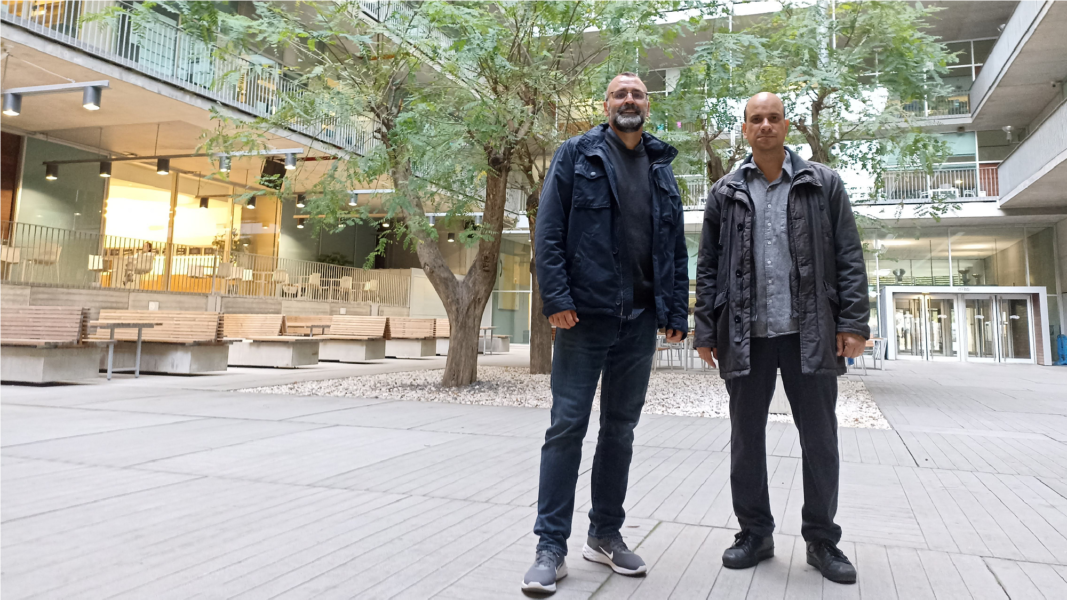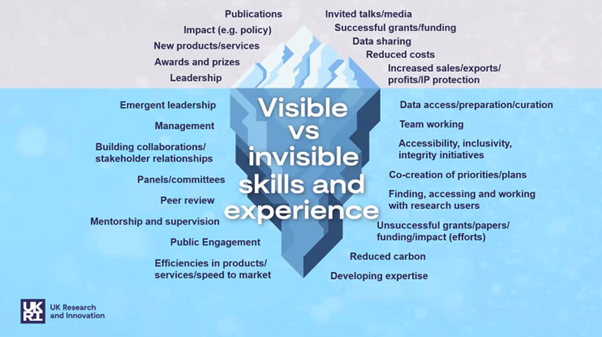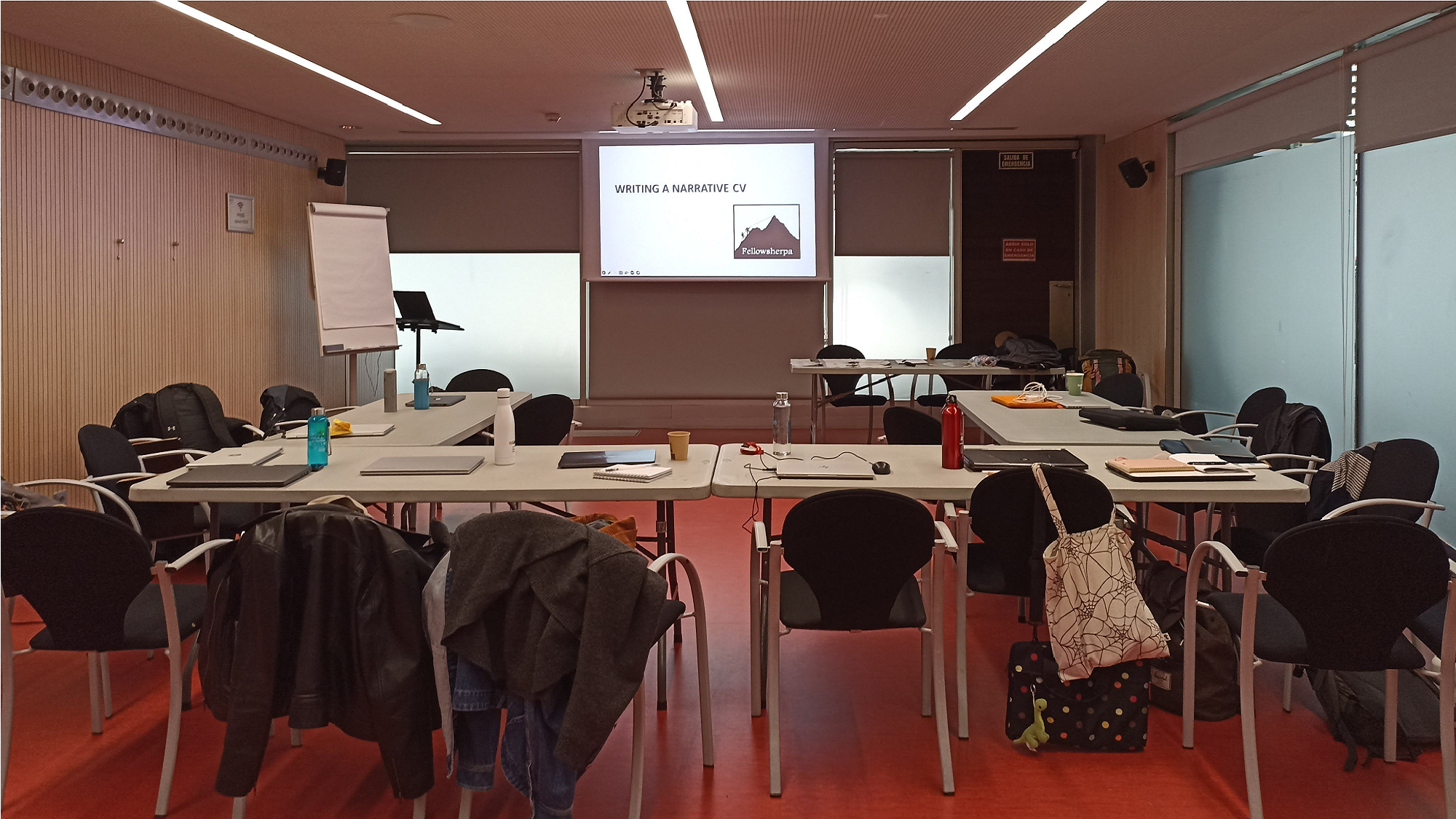On 21st Marh, 14 participants from the PRBB centres did a whole day Intervals course on Narrative CVs, with ex-biology researchers and now science communicators and trainers Thiago Carvalho and David del Álamo, from FellowSherpa.
A Narrative CV can be defined as “a form of CV that uses a narrative style to explain the ‘why’ ‘who’ and ‘how’ behind the ‘what’”, in the words of Rachel Herries, Research Culture Manager at the University of Glasgow. The most common template used by European funders originated from The Royal Society, in accordance with DORA, as part of the growing movement to reform research assessment and improve research culture.
Non-narrative CVs
The participants started discussing what’s wrong with a traditional CV: one that consists of a list of items related to your education, papers, experience, skills and sometimes even hobbies.
Perhaps a comment that summarises well the responses is that “it’s like giving a list of ingredients, but not the recipe”. There’s no story, the elements are not linked, it’s not personal.
A traditional CV is like giving a list of ingredients, but not the recipe. There’s no story.
Specially when your career is not linear (you may have studied physics and are now working on medicine; or there’s a 3 year gap in your career) there usually is a story, a narrative, that might explain it, make sense of it, and add value. That is lost in a traditional CV.
Lessons learned from failures are something else that is usually not included in a CV –and is something that those in charge of hiring really appreciate, says Thiago, who used to be head of graduate programmes at the Gulbenkian Institute of Science and graduate studies coordinator at the Champalimaud Foundation. “Your honesty about things that didn’t work gives me reassurance that you have integrity”, he explains.

Narrative CVs: the ‘what’
But what is a narrative CV? According to DORA, “a structured description of a researcher’s contributions and achievements that reflect a broader range of skills and experiences beyond publications and funding record”. In other words, everything you have done to contribute to society, not only the published results of your research project; do you go to schools to do outreach activities? Are you involved in lots of commissions, in gender equality issues, in editorial or peer review work – or do you create art related to your science? Do you do mentoring?
These CVs include aspects of what one would normally include in a cover letter, which aims to explain what you can offer to that specific job; and others of what would be incorporated on a competence-based interview, where you may be asked to explain when and how did you put your skills into practice (e.g. when did you successfully prove you have leadership skills?). But a narrative CV it’s more than a combination of the traditional CV and a cover letter.
It’s also important to understand what is not a narrative CV. “The most common mistake when doing a narrative CV is taking the list of the traditional CV and adding in front of each item “I did..”: I did a PhD, I published this paper; I did XXX”, cautions Thiago. “That’s not a story. You have to make it a story”.
Narrative CVs: the ‘why’ and the ‘how’
“Why should someone who chooses to focus all their time on their research project and does nothing for the community, be considered equally valuable (or even more) than others who dedicate a big chunk of their time to other activities that add value to society? This is what we want to change with narrative CVs”, says David, who used to be head of the EMBO Fellowship programme. “Publishing a paper is not an achievement. The achievement is the discovery, which was then communicated to the community”, adds the trainer.
The institutions that ask for narrative CVs tend to give quite specific instructions about what they want you to include: whether it’s personal details; your 10 most important research achievements, including their impact in the field and your role in the project; a 50-word description of your one major accomplishment; or additional information such as career breaks, a diverse or non-traditional career path, major life events or other noteworthy contributions to the scientific community.
More information on narrative CVs can be found in the UK Research and Innovation (UKRIO) website or the Royal Society’s Résumé for Researchers template. This very widely used template for narrative CVs asks for information in four ‘concentric circles’, from the individual to the societal level:
- How have you contributed to the generation of knowledge – this would include your publications, but also other research outputs, such as databases, clinical practice products, educational resources, patents, etc. It can include, too, funding or awards received.
- How have you contributed to the development of other individuals – here you can include anything you did that was important to the success of your team or its members, including project management, collaborative contributions, etc. It covers also teaching activities, supervision and mentoring, or any strategic leadership you may have demonstrated.
- How have you contributed to the wider research community – this would cover reviewing or evaluating the work of others, committee membership, work on research integrity, gender and diversity, organising conferences, etc.
- How have you contributed to broader society – here you can add any public engagement activities aimed at the general public, citizen science projects, or engagement with industry or the private sector. It also includes contacts with patient organizations, policy or decision-makers or the media.
There’s also an “Additions” section to include any further information that can help explain your story, such as career breaks (due to maternity or paternity, or any other significant life event) and others.
There are other templates, from other funding agencies, all based on similar concepts. In all cases, suggest the trainers, you should add whatever objective evidence you have of the impact and relevance of your achievements.

Narrative CVs: the challenges
Narrative CVs have clearly lots of potential advantages. But how is the scientific community accepting this new trend? “In theory everyone likes them; in reality it’s just one more thing you have to do…”, says Thiago. David and himself have experience helping researchers to write their narrative CVs and know some of the intricacies and challenges. But their message is positive: “If you were fine before (with traditional CVs), you will still be fine now”, says Thiago. “But if you were in one of the categories that were further apart from the traditional path, narrative CVs give you a better chance”.
“If you were fine with traditional CVs, you will still be fine now. But if you were in one of the categories that were further apart from the traditional path, narrative CVs give you a better chance”
Thiago Carvalho
There’s also data about what the grant reviewers have to say. Some have complained that they didn’t quite know where to find the relevant information. Others worry that the better your English writing skills are, the better chances you have. Thiago suggests, to compensate this bias, to start early, try to ask for help and stick to clear, understandable vocabulary – beware that, more than likely, many of the reviewers won’t be native English speakers.
Many reviewers also confess that, after everything, they went online to check the publication record of the applicant. “There will always be some people who do this – less and less, with the generational change – but there are others who won’t. And at least, even if they check your publications on the side, the narrative CV gives you an opportunity to add something more”, says Thiago.
Some other tips that the course trainers gave the participants include:
- Be clear in your writing
- Read the instructions carefully, specifically regarding the format and rules.
- Ask questions is you have doubts about the call, including to the contact person at the funding agency.
- Always have someone else to read your draft!
To the complaint that narrative CVs might make an objective selection more difficult, compared to a list of publications with their impact factor, David says: “Well, is that publication list actually objective? I don’t think so. I did a study when I was at EMBO, to compare how the successful applicants had done, longer term, compared to the next 200 non-successful candidates. There was no difference. In fact, the only relevant ‘success indicator’ was being a man. Which shows how biased the traditional selection system is, despite our idea that it is objective. To be fair, a lottery system among the best applicants would be fairer!”.
He adds that there are concerns and room for improvement, but overall narrative CVs are a positive change. And they are definitely here to stay.
Narrative CVs: the present and the future
Several institutions all over Europe (as well as the NIH in the US) are already using narrative CVs. “Everything started only three or four years ago; it’s still pretty new. But the good thing is that it’s been field-tested and there are even a few studies about the outcomes”, says Thiago.
One of the biggest movements pushing for narrative CVs is CoARA, the Coalition for the Advancement of Research Assessment. “More than 800 organisations have signed so far (Barcelona Institute for Global Health (ISGlobal) and Centre for Genomic Regulation (CRG) are two centres at the PRBB who are signatories of CoARA), and it’s growing exponentially. Their report on reforming research assessment includes as a recommendation to consider narrative CVs”, explains David.
The ERC also adopted narrative CVs this year – which means soon everyone else will start following suit, expects Thiago. David agrees “I think we will end up seeing some aspects of a narrative CV absolutely everywhere. Maybe not the full version, because there are challenges and unsolved issues with them, but at least some aspects, for sure”.







